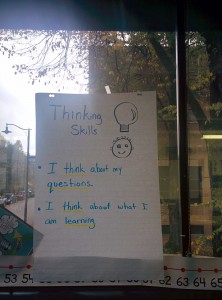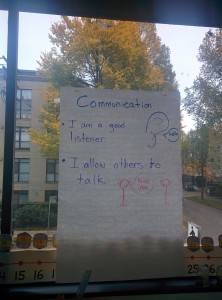IB Transdisciplinary Skills in Grade 1
Relatively fresh from kindergarten, Grade 1 students have a lot more responsibility and expectations as they continue into their primary education. These new graduates are certainly inquisitive when their school environment fosters exploration. Applying new skills into their learning is essential for their ability to construct meaning of what they are learning. Using the IB curriculum, students are taught a set of transdiscilinary skills that they can apply during learning and in life outside of the classroom. The transdiscilinary skills taught are: social skills, communication skills, thinking skills, research skills and self-management skills.
 This week I presented a lesson on the mentioned skills to my Grade 1 students. Connections were easily made during the week to the transdiscilinary skills and the students understanding of them became more useful. Setting the foundation for the students to apply meaning into what they are learning seems to make a lot of sense!
This week I presented a lesson on the mentioned skills to my Grade 1 students. Connections were easily made during the week to the transdiscilinary skills and the students understanding of them became more useful. Setting the foundation for the students to apply meaning into what they are learning seems to make a lot of sense!
Lesson:
Part A: TASK.
Not introducing any background information on the transdiscilinary skills, students were given the challenge to split into groups of 3 and to construct a numb er line that included a pattern. This task would create the opportunity for them to collaborate and use their social skills, communication skills, thinking skills, research skills and self-management skills. The lesson also tied in previous knowledge as the students had been making patterns and number lines in their math class.
er line that included a pattern. This task would create the opportunity for them to collaborate and use their social skills, communication skills, thinking skills, research skills and self-management skills. The lesson also tied in previous knowledge as the students had been making patterns and number lines in their math class.
I was blown away by their creations and, already, use of many of the transdiscilinary skills that we would soon study.
Part B: UNDERSTANDING THE IB TRANSDISCILINARY SKILLS.
 Completing the task, I asked the group to meet in the middle of the classroom. I had pointed out some new and unfamiliar posters around the room. I explained to the students that we would be learning about some special skills that will help us in school, at home and in our community. Together, we read each poster and made an example to help us understand. The students responded very well when relating these skills to home or in other school subjects.
Completing the task, I asked the group to meet in the middle of the classroom. I had pointed out some new and unfamiliar posters around the room. I explained to the students that we would be learning about some special skills that will help us in school, at home and in our community. Together, we read each poster and made an example to help us understand. The students responded very well when relating these skills to home or in other school subjects.
Part C: ACTION.
After learning the skills,I asked the students to think back to their task from the beginning of class and to walk to the skill that they used most while in their group this morning. The students were engaged and walked to the poster that represented them best. When I asked anyone to explain why there were standing there, a lot of students raised their hands and had thoughtful responses. At this moment, I was very impressed with what they had learned and understood well the benefit of inquiry learning. Using the task in the morning, a lesson to teach the concept, and then applying our knowledge, our students understood well these foundational skills.